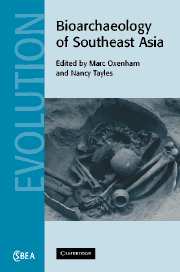Book contents
- Frontmatter
- Contents
- List of contributors
- Foreword: Emerging frontiers in the bioarchaeology of Southeast Asia
- Preface
- 1 Introduction: Southeast Asian bioarchaeology past and present
- Part I Morphological diversity, evolution and population relationships
- Part II Health, disease and quality of life
- Part III Conclusions
- Index
- References
Foreword: Emerging frontiers in the bioarchaeology of Southeast Asia
Published online by Cambridge University Press: 18 November 2009
- Frontmatter
- Contents
- List of contributors
- Foreword: Emerging frontiers in the bioarchaeology of Southeast Asia
- Preface
- 1 Introduction: Southeast Asian bioarchaeology past and present
- Part I Morphological diversity, evolution and population relationships
- Part II Health, disease and quality of life
- Part III Conclusions
- Index
- References
Summary
Much has changed in the two decades since Karl Hutterer (1982) lamented that tropical Southeast Asian archaeology had not advanced much beyond antiquated models based on limited empirical evidence. Indeed, in just the last few years, the scope of archaeology of this region has expanded in new and exciting ways (see Bellwood 1997, Higham and Thosarat 1998, Junker 1999, Higham 2003, Glover and Bellwood 2004). In reading the published archaeological literature on the region before the 1990s, one cannot help but ask why human remains – a highly visible part of this record, having been recovered from such well-known sites as Non Nok Tha and Ban Chiang in Thailand and Niah Cave in Borneo – have not been brought into the discussions about such issues as adaptation, landscape use, population history, settlement, subsistence practices and dietary shifts. Indeed, in this as in other areas of the world, the adoption of agriculture led to fundamental alterations of cultures and landscapes. Human remains provide an informative record of this important adaptive transition (e.g. Krigbaum 2003). Why not include them?
One reason for the lack of inclusion of human remains in developing an understanding of the prehistory of the region is that very little beyond descriptions of skeletons (e.g. Brooks et al. 1979) had been published prior to the mid 1990s. The other reason is that archaeologists have oftentimes viewed skeletons as not particularly informative about the past.
- Type
- Chapter
- Information
- Bioarchaeology of Southeast Asia , pp. xi - xivPublisher: Cambridge University PressPrint publication year: 2006



